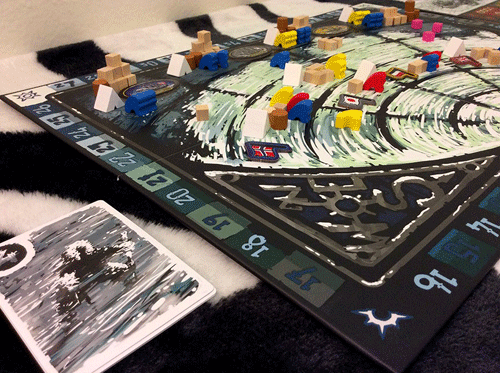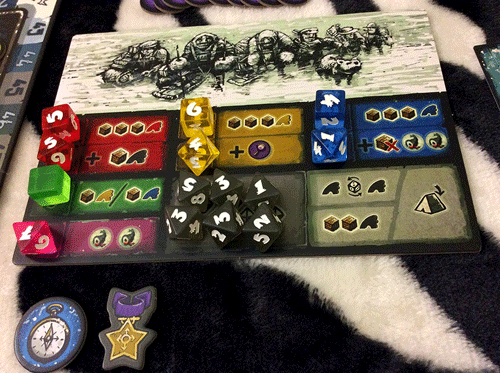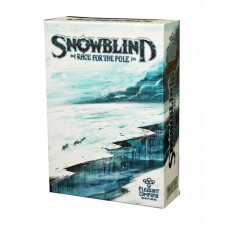Snowblind: Race for the Pole Review
on Dec 21, 2016
In 1911, Norwegian Roald Amundsen became the first man to reach the South Pole, beating England's Robert Falcon Scott by only one month and achieving what previous expeditions from every country around the globe could not. Snowblind, a push-your-luck, resource-management dice game by Pleasant Company Games, is not nearly so monumental. Despite a risk-based action selection mechanic that I've never seen before, it lacks the driving force that motivated explorers like Amundsen and Scott to brave the pack ice again and again.

Like Ancient Terrible Things, the hand-drawn art is dynamic and atmospheric.
Like Pleasant Company's prior (and better) game, Ancient Terrible Things, Snowblind is simple to pick up. On the small Expedition board, meeples representing sailors, scientists and your expedition's captain, as well as barrels and crates of provisions and your nation's flag, wait with your country's ship. By picking up colored six-sided or eight-sided dice, players take actions like moving explorers and supplies, hunting for food, and building camps. The goal is to get your captain (the only explorer allowed to touch the flag) to the pole and back to your ship before the Pack Ice card is revealed from the Weather deck.
Where's the "push your luck," you ask? After each action, you must conduct an Exposure roll affecting the space of the action (e.g. where you ended your movement or established a camp). This means rolling your entire pool of dice, including the one you just took and any dice in your pool from previous actions the same round. For every bad roll, you must expend a crate of supplies, exhaust an explorer, or allow an exhausted explorer to expire. What counts as a "bad roll" depends on the conditions of the space: 1-3 are always safe, 4 counts as exposure unless company (a minimum of two explorers) is present, 5 counts as exposure unless a camp is present in the space, and 6+ is always bad.

The risk-based action selection is the best part of the experience.
The interplay between these dice and their associated actions is the most interesting part of the game. Some actions are better than others, but most can be selected only once per round, so you want to get to the good ones quickly before your opponents do. On the other hand, the stronger actions force you to take a d8 rather than a d6, so if you take these for your first action of the round, you're going to be doubling your odds of exposure not just this turn, but for every future action this round. There's even a weak action associated with a blank d6, which doesn't add to your risk at all (but you still need to roll).
Because a single bad roll on two dice can kill your captain outright, eliminating you from the game, most of the game involves a sort of logistical transport chain, making sure there are explorers, supplies and camps at every stop to keep your captain protected. Of course, the endgame scoring only rewards you for explorers and crates that safely made it back to your ship, so planning is rewarded.
Which is sort of the problem. Because consuming supplies and killing explorers will lower your final score, there's a heavy disincentive to take unnecessary risks, and the time limit imposed by the Pack Ice isn't strict enough. In every game I've played, all the teams made it to the pole and back, with the game being decided by remaining explorers and supplies. Since rolling dice is the only way you can lose supplies (aside from the once-a-round Weather card), you're heavily encouraged to keep dice-rolling, increasing the impact of unlucky rolls.
The core push-your-luck mechanic is solid and unique, but there's sadly not enough incentive to push your luck very far, and exciting occurences of exhausted explorers or dead captains are rare indeed. A fun diversion for a wintry day, but less revolutionary than you'd think.

 Customer Support
Customer Support  Subscribe
Subscribe 




 Account
Account  Wishlist
Wishlist 

